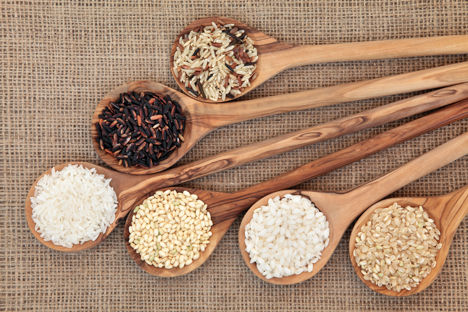
Everything you need to know about rice
Know your basmati from your jasmine? Want to understand why risotto rice goes so wonderfully creamy? Rice is one of – if not the most – important ingredients in the world; get to grips with the grain and improve your cooking in the process.
Everything you need to know about rice
Know your basmati from your jasmine? Want to understand why risotto rice goes so wonderfully creamy? Rice is one of – if not the most – important ingredients in the world; get to grips with the grain and improve your cooking in the process.
In the average supermarket, there are probably under ten different varieties of rice on offer. However, there are over 40,000 cultivated all over the world. Each one can be divided into three categories: long-, medium- or short-grain, depending on their shape and size. Some are multi-purpose, whereas others are associated with specific dishes.
In short, rice is the seed of the grass species Oryza Sativa, which requires lots of water to grow. Once harvested, grains are milled to remove the outer inedible husk. At this point they are known as brown rice, which has the highest nutritional content, has a firmer texture and a distinctive nutty flavour. To make white rice, the seeds are then milled further until the bran is removed. Some grains are steamed in the husk, a process called parboiling, whereby the nutrients migrate into the centre of the grains and the starch solidifies, resulting in firmer grains.
Knowing which rice to cook for use in a particular cuisine or dish is key to an authentic experience. We’ve put together a guide to the ten most common types of rice and the cuisines they’re best used in, so you can choose the right kind to serve for dinner tonight.
Rice varieties
In India, Pakistan and the Middle East, basmati rice is king. Pure Basmati rice can only be grown and harvested in one place on Earth, at the foothills of the Himalayas.The grains are longer and slender than standard long grain rice, and aromatic with a subtle nutty flavour. Once cooked, the grains fluff up and separate, complementing curries and other heavily spiced dishes. It can be bought in white (the most common), brown (which is even nuttier) and easy cook varieties. All popular rice-based dishes from India are best made with basmati. Uniquely, the Basmati grain expands more than twice its dry length during cooking. Unlike other types of rice the grains only expand lengthways resulting in the grains retaining their long slender characteristic when cooked. The open texture of Basmati allows the grain to absorb other flavours, making it well suited to a whole host of recipes and cuisines.
With the bran layer intact, wholegrain rice has a distinctive nutty flavour. It is rich in nutrients and natural fibre, making it the ultimate rice for a healthy lifestyle, and has a low to medium GI which helps you feel fuller for longer. It is delicious in soups, salads, vegetable mixtures such as ratatouille and stronger flavoured casseroles.
With a deep purple, almost black colour and all sorts of health benefits, black rice has enjoyed a cult following for many years. It’s also known as forbidden rice because it used to be reserved for the Emperor of China and his family – anyone else caught eating it would be put to death. The grains have a delicate aroma and firm texture, are full of antioxidants and add eye-catching flair to any dish. Black rice goes particularly well with Chinese dishes.
Jasmine rice (also known as Thai fragrant rice) is a shorter grain with a sticky texture. The sticky grains are glutinous, perfect for accompanying sauces that cling to the rice easily. Jasmine rice is particularly well suited to Thai cuisine, but works well with the majority of Chinese and South East Asian dishes.
This rice is popular in the world and is used in all manner of dishes, from Chinese to Mexican. The grains remain very separate once cooked and have a very subtle flavour, which makes it a particularly versatile ingredient. It is a staple in Chinese cuisine but is also used in dishes across the globe.
There are several different paella rice varieties favoured throughout Spain, but the most well-known are bomba and calasparra. These grains are much shorter than long-grain, almost spherical in appearance, and absorb twice as much liquid as longer varieties. Paella rice doesn’t stick together as it retains most of its starch content as it cooks, instead absorbing the other flavours in a dish as it plumps up. Unsurprisingly, paella rice is reserved for making paella, a dish which isn’t stirred as it cooks, which helps the grains retain their starch.
A generic British term for short-grain rice, pudding rice is round and releases plenty of starch while cooking (which is helped along by regular stirring), resulting in a creamy finish and soft texture. It is used to make various rice puddings.
Risotto rice comes in many forms which come from different regions of Italy. Arborio is the most common, but carnaroli and vialone nano are seen as superior (all of which are grown in and around Piedmont). The grains release lots of starch as they cook, resulting in a creamy, tender mass as the rice absorbs liquid. Used to make risotto, they also form the base of arancini.
Slightly sticky but with grains that remain defined and separate once cooked, sushi rice has just the right amount of starch to be shaped into balls which won’t fall apart. The short-grain varieties used in sushi are known as uruchimai and have a sweet flavour, with the majority being grown in Japan. However, California, Italy and Spain also grow a large amount of sushi rice for their respective local markets.
Wild rice technically isn’t a rice at all, but is in fact a grass seed from the US. However, it is often mixed into bags of long-grain rice to add texture, colour and flavour. It is very chewy, contains lots of protein and fibre and tastes sweet.
It's safe to say Alex Waugh of The Rice Association knows everything there is to know about rice. Here are his top tips for cooking the grains at home and why we should be eating more.
* Choose the right rice for the dish. There are many different types of rice available in Britain – probably more than in rice producing countries. These include fragrant basmatis from India and Pakistan, deliciously sticky and aromatic Thai rice, creamy risotto rices from Italy, paella rice from Spain, coloured rices like Camargue red or black Venere from Italy and many more. Your choice will affect the appearance, aroma, texture and overall flavour of the dish.
* Leaving long grain rices such as basmati rice to stand for a few minutes after cooking and draining (if necessary) will help it mature and mean that excess water is steamed off. Simply forking through basmati afterwards should mean you have perfectly separated grains.
* It is not necessary to pre-soak rice before cooking, but if you do the amount of water it will absorb and cooking time will both be less.
* Rice can be cooked in a microwave. Cooking times vary according to the device and power settings, but they are similar to cooking on the hob. If you like to get ahead, it can also be part cooked on the hob, then rinsed and kept in the fridge chilled, before finishing off in the microwave.
* If you plan to keep cooked rice, it is important that it is cooled quickly, covered and stored in the fridge for a maximum of three days.
* Rice is naturally low fat and gluten-free, meaning you don’t have to worry about whether your guests have an intolerance or are on a diet
* Don’t be afraid to experiment. Because there are so many different kinds of rice available, it can be used to substitute for other foods like potatoes and pasta and give an old recipe a new twist.



